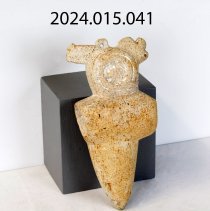Search Term Record
Metadata
Name |
International Art |
Related Records
-
1966.034 - Leaf
This is a leaf from a late medieval/early Renaissance illuminated manuscript, specifically a special notice of St. Martin of Tours in Calendosa from a book of hours. The leaf is a single page with two sides, upon each of which are twelve lines of Latin in blackletter Gothic script. The first letter of each individual sentence is illuminated with blue and red paint and gold-leaf lettering as well as occasional decorative illumination within the li...
Record Type: Object
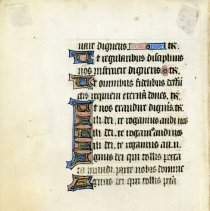
-
1968.002 - Print
This black and white ink print on paper titled "Iconography" by Sir Anthony van Dyck depicts an etched portrait of Charles Emmanuel, Duke of Savoy in armor carrying a baton. He is shown in contemporary military regalia, wearing around his neck the collar badge of the Supreme Order of the Most Holy Annunciation, which depicts the Annunciation by the archangel Gabriel to Mary. The caption beneath the image reads: "Carolvs Emmanvel Dvx Sabavdiae...
Record Type: Object
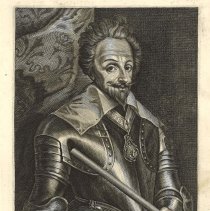
-
2024.015.029 - Carving
This ritual carving originates from the Akehon People of the Sepik River mapnik region in New Guinea, Oceania. Carved figures from Papua New Guinea, Oceania normally represented gods, deities, or ancestral heroes. They were sometimes made free-standing but are also found as part of a larger object like the top of a house pole. New Guinea figures vary in size from very small charms hidden on one's person to monumental sizes. Wooden figures ...
Record Type: Object
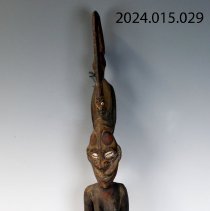
-
2024.015.031 - Vessel
This stirrup spout vessel with bird motif originates from the Moche culture of Peru, South America. Ceramics of this form are called stirrup spout vessels--the shape of the spout recalls the stirrup on a horse's saddle--and were a much-favored form on Peru's northern coast for about 2,500 years. Special thanks to Dr. Althia Ali for researching this vessel alongside Reece Museum staff. This research was made possible by the Luce Foundation...
Record Type: Object
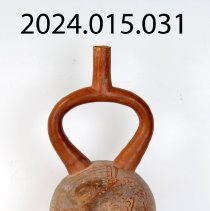
-
2024.015.038 - Mace, Ceremonial
This ceremonial mace head with stylized macaw head, or ceremonial double-headed pestle, originates from the Guanacaste Nicoya area of Costa Rica, Central America. In the ancient Caribbean, the heads of ancestors were objects of devotion, kept in special baskets in the round temples known as bohíos. The head, rather than other bones, was kept because the Taíno people believed that spiritual power in the body resided in the head, particularly t...
Record Type: Object

-
2024.015.041 - Pestle
This pestle carved in dense stone, or ceremonial mace head with stylized macaw, originates from the Arawak People of the West Indies. A mace is a blunt weapon, a type of club that uses strength on the end of a handle to deliver powerful strikes and bludgeon its target on impact. It typically consists of a strong, heavy, wooden or metal shaft, often reinforced with metal and has a head made of stone, bone, copper, bronze, iron, or steel. Mac...
Record Type: Object
